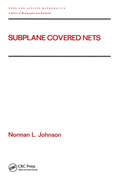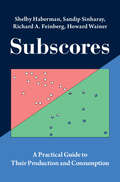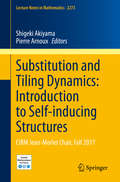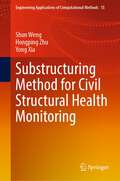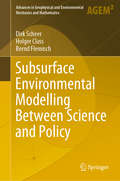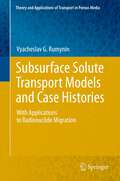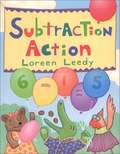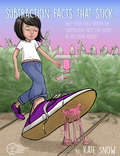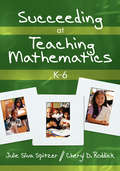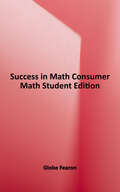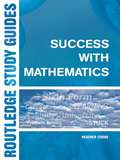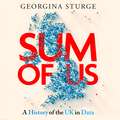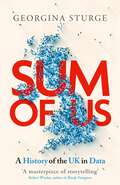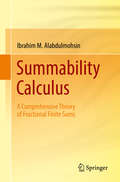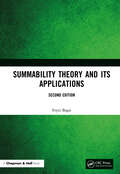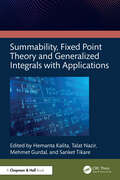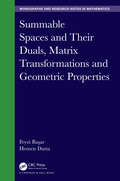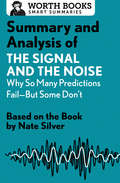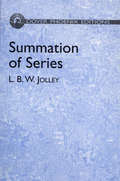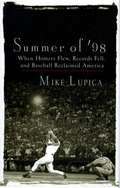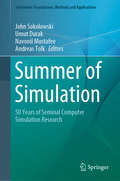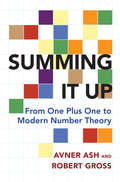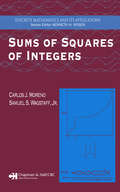- Table View
- List View
Subplane Covered Nets (Chapman & Hall/CRC Pure and Applied Mathematics)
by Norman L. JohnsonThis work confronts the question of geometric processes of derivation, specifically the derivation of affine planes - keying in on construction techniques and types of transformations in which lines of a newly-created plane can be understood as subplanes of the original plane. The book provides a theory of subplane covered nets without restriction
Subscores: A Practical Guide to Their Production and Consumption
by Shelby Haberman Sandip Sinharay Richard A. Feinberg Howard WainerThis authoritative guide directs consumers and users of test scores on when and how to provide subscores and how to make informed decisions based on them. The book is designed to be accessible to practitioners and score users with varying levels of technical expertise, from executives of testing organizations and students who take tests to graduate students in educational measurement, psychometricians, and test developers. The theoretical background required to evaluate subscores and improve them are provided alongside examples of tests with subscores to illustrate their use and misuse. The first chapter covers the history of tests, subtests, scores, and subscores. Later chapters go into subscore reporting, evaluating and improving the quality of subscores, and alternatives to subscores when they are not appropriate. This thorough introduction to the existing research and best practices will be useful to graduate students, researchers, and practitioners.
Substitution and Tiling Dynamics: CIRM Jean-Morlet Chair, Fall 2017 (Lecture Notes in Mathematics #2273)
by Shigeki Akiyama Pierre ArnouxThis book presents a panorama of recent developments in the theory of tilings and related dynamical systems. It contains an expanded version of courses given in 2017 at the research school associated with the Jean-Morlet chair program.Tilings have been designed, used and studied for centuries in various contexts. This field grew significantly after the discovery of aperiodic self-similar tilings in the 60s, linked to the proof of the undecidability of the Domino problem, and was driven futher by Dan Shechtman's discovery of quasicrystals in 1984. Tiling problems establish a bridge between the mutually influential fields of geometry, dynamical systems, aperiodic order, computer science, number theory, algebra and logic. The main properties of tiling dynamical systems are covered, with expositions on recent results in self-similarity (and its generalizations, fusions rules and S-adic systems), algebraic developments connected to physics, games and undecidability questions, and the spectrum of substitution tilings.
Substructuring Method for Civil Structural Health Monitoring (Engineering Applications of Computational Methods #15)
by Yong Xia Shun Weng Hongping ZhuThis book investigates the substructuring technology in structural health monitoring (SHM) to improve the accuracy and efficiency of the present SHM methods. SHM has been developed for monitoring, evaluation, and maintenance of civil structures. As the civil structures are usually large scale and a large number of sensors are deployed on a structure, accurate evaluation and maintenance of civil structures are always time-consuming. The book establishes a fundamental framework of substructuring method for the fast analysis of finite element (FE) model and monitoring data. Several practical civil structures are used for illustration. The book is intended for undergraduate and graduate students who are interested in SHM technology, researchers investigating the accurate, efficient, and effective methods in SHM field, and engineers working on evaluation and maintenance of civil structures or other structural dynamics applications.
Subsurface Environmental Modelling Between Science and Policy (Advances in Geophysical and Environmental Mechanics and Mathematics)
by Dirk Scheer Holger Class Bernd FlemischThis book provides a broad overview of essential features of subsurface environmental modelling at the science-policy interface, offering insights into the potential challenges in the field of subsurface flow and transport, as well as the corresponding computational modelling and its impact on the area of policy- and decision-making. The book is divided into two parts: Part I presents models, methods and software at the science-policy interface. Building on this, Part II illustrates the specifications using detailed case studies of subsurface environmental modelling. It also includes a systematic research overview and discusses the anthropogenic use of the subsurface, with a particular focus on energy-related technologies, such as carbon sequestration, geothermal technologies, fluid and energy storage, nuclear waste disposal, and unconventional oil and gas recovery.
Subsurface Solute Transport Models and Case Histories
by Vyacheslav G. RumyninThe book addresses the development of the basic knowledge of the subsurface solute transfer with a particular emphasis on field data collection and analysis coupled with modeling (analytical and numerical) tool application. The relevant theoretical developments are concerned mainly with the formulation and solution of deterministic mass-transport equations for a wide range of engineering issues in groundwater quality assessment and forecasting. The book gives many computational examples and case studies drawn from the conducted field investigations. The analyzed problems are as follows: investigation and prediction of groundwater contamination by industrial contaminants and solutions (radionuclides, chloride and nitrate brine) with special focus on the effect of (a) aquifer heterogeneity, anisotropy, and dual porosity, (b) density contrast existing between industrial waste and groundwater, or in density-stratified artesian and coastal groundwater systems; (c) physicochemical interactions that play a major role in retarding (e.g. adsorption) or enhancing (e.g. interactions between dissolved species and mobile colloids) contaminant transport;prediction of the effects of pumping on groundwater quality at wellfields;groundwater dating using stable and radioactive isotopes for prediction and assessment of contamination potential;field and laboratory tests' design and analysis, and monitoring data interpretation;partitioning of surface and subsurface flows using isotope techniques.One of the most essential topics addressed in the book is the migration and fate of radionuclides. Model development is motivated by field data analysis from a number of radioactively contaminated sites in the Russian Federation: near-surface radioactive waste disposal sites and deep-well radioactive waste injection sites. They play a unique role in the advancement of knowledge of the subsurface behavior and fate of many hazardous radionuclides and can be considered as field-scale laboratories. Thus, the book, along with theoretical findings, contains field information, which will facilitate the understanding of subsurface solute transport and the development of a methodology for practical applications to groundwater hydrology.
Subtraction Action
by Loreen LeedyIntroduces subtraction through the activities of animal students.
Subtraction Facts that Stick: Help Your Child Master the Subtraction Facts for Good in Just Eight Weeks
by Corrin Brewer Debra Pearson Kate SnowThe fun, engaging program that will help your child master the subtraction facts once and for all—without spending hours and hours drilling flash cards! Subtraction Facts That Stick will guide you, step-by- step, as you teach your child to understand and memorize the subtraction facts, from 1 - 1 through 9 - 9. Hands-on activities, fun games your child will love, and simple practice pages help young students remember the subtraction facts for good. In 15 minutes per day (perfect for after school, or as a supplement to a homeschool math curriculum) your child will master the subtraction facts, gain a greater understanding of how math works, and develop greater confidence, in just six weeks! Mastery of the math facts is the foundation for all future math learning. Lay that foundation now, and make it solid, with Subtraction Facts That Stick!
Succeeding at Teaching Mathematics, K-6
by Dr Cheryl D. Roddick Julie A. Sliva SpitzerThis invaluable resource helps beginning educators focus on the big ideas in teaching mathematics and promote student engagement.
Succeeding at Teaching Secondary Mathematics: Your First Year
by Dr Cheryl D. Roddick Julie A. Sliva SpitzerThis practical resource helps beginning secondary mathematics teachers design a curriculum that is meaningful, differentiate instruction, engage students, meet standards, assess student understanding, and more.
Success in Math: Consumer Math (Success in Math Series)
by Globe FearonThis book helps students with varying learning styles master basic math concepts and prepares them for success on math competency tests. Student Texts This five-book softcover series breaks down core math concepts into short, manageable lessons that assume little background knowledge and are introduced in real-life contexts. In addition, chapter opener vocabulary lists and a glossary prove valuable for English language learners with below- or at-level math skills. Teacher's resources include answer Keys, as well as error analysis notes, alternative strategies for varied learning styles, problem-solving strategies, ESL notes, cooperative learning strategies, and reproducible masters are provided. - Helps students with varying learning styles master the basic math concepts they need to meet rigorous high school math and testing requirements. - Introduces students to the working world by presenting real-world examples and problems. - Supports independent learning with instruction, exercises, and partial Answer Keys.
Success with Mathematics
by Heather CookeMany students find the leap between school and university level mathematics to be significantly greater than they expected. Success with Mathematics has been devised and written especially in order to help students bridge that gap. It offers clear, practical guidance from experienced teachers of mathematics in higher education on such key issues as: * getting started* ways of studying* assessment* mathematical communication* learning by doing* using ICT* using calculators* what next.After reading this book, students will find themselves better prepared for the change in pace, rigour and abstraction they encounter in degree level mathematics. They will also find themselves able to broaden their learning strategies and improve their self-directed study skills. This book is essential reading for anyone following, or about to undertake, a degree in mathematics, or other degree courses with mathematical content.
Suficientes zanahorias: Just Enough Carrots (Spanish Edition) (MathStart 1)
by Stuart J. Murphy“Kids, young and old, fall in love with math when they see how real-life and effortless it becomes thanks to these books.” —Kimberly D. Mueller, Ed.D., First Grade Teacher, Ashbrook School, Lumberton NJThis high-quality Spanish-language book can be enjoyed by fluent Spanish speakers as well as those learning the language, whether at home or in a classroom.The MathStart series has sold over 1.5 million copies and combines math with fun stories that have real-life applications. In Suficientes zanahorias, a Level One MathStart, children learn to formulate addition and subtraction equations and identify “more,” “fewer,” and “the same.”Cuando Conejo va de compras al supermercado con su mamá, comparar cantidades le resulta fácil. Sabe lo que deben comprar: á más zanahorias y menos lombrices!Math skills are life skills, and the MathStart series supports success!This award-winning series by Stuart J. Murphy teaches math through stories and visual models63 books divided into three levels with 21 books in eachFun activities kids will love are included to help parents and teachers emphasize the lessonsEngaging and relatable stories, with each story revolving around practical applications of the math concept presentedLively art from top-notch illustratorsCharts and other visual representations help children understand how the math works and promote deeper comprehensionMathStart's unique combination of stories, illustrations, and visual models helps teachers and parents in the teaching of math and provides all children with the opportunity to succeed.The math concepts taught in MathStart books conform to state and national standards. Level 1 is Pre-K–Kindergarten; Level 2 is Grades 1–3; Level 3 is Grades 2–4. The series follows math topics across grades so there is a foundational path to learning that runs through the levels.Help kids with their math skills plus their reading skills with the engaging and fun MathStart series!
Sum of Us: A History of the UK in Data
by Georgina SturgeWhat has data ever done for us?Georgina Sturge, House of Commons Library statistician and author of the critically acclaimed Bad Data, explores the rich history of the times the UK has counted itself - from the revolutionary first census of 1801 to modern worries over technological surveillance.Condensing a whole society into numbers brought hidden problems to light: mapping cholera deaths in Soho led researchers to a single deadly water pump; Florence Nightingale stunned the Victorian establishment with her diagrams showing disease was the soldier's hidden enemy; and the discovery that industries like firework-making were almost entirely staffed by women helped improve workers' rights.The census also reveals the people left out of the nation's story. Records reveal the remarkable presence of escaped American slaves living in nineteenth century Leeds, and that by 1901 there were 600 professional Italian cooks in the UK. More recent data has acknowledged religion, ethnicity, and LGBT identity for the first time. Sturge also tracks those who have resisted the state's attempts at tabulation - people burning survey forms, stripping naked in protest and, in the case of 500 Suffragettes, avoiding the 1911 census by skating all night round Aldwych roller rink.Full of fascinating social detail, Sum of Us draws out the human stories captured in the vast tangle of data the UK has collected over two centuries. It provides a vital snapshot not of who we imagine ourselves to be - but who we really are.
Sum of Us: A History of the UK in Data
by Georgina SturgeWhat has data ever done for us?Georgina Sturge, House of Commons Library statistician and author of the critically acclaimed Bad Data, explores the rich history of the times the UK has counted itself - from the revolutionary first census of 1801 to modern worries over technological surveillance.Condensing a whole society into numbers brought hidden problems to light: mapping cholera deaths in Soho led researchers to a single deadly water pump; Florence Nightingale stunned the Victorian establishment with her diagrams showing disease was the soldier's hidden enemy; and the discovery that industries like firework-making were almost entirely staffed by women helped improve workers' rights.The census also reveals the people left out of the nation's story. Records reveal the remarkable presence of escaped American slaves living in nineteenth century Leeds, and that by 1901 there were 600 professional Italian cooks in the UK. More recent data has acknowledged religion, ethnicity, and LGBT identity for the first time. Sturge also tracks those who have resisted the state's attempts at tabulation - people burning survey forms, stripping naked in protest and, in the case of 500 Suffragettes, avoiding the 1911 census by skating all night round Aldwych roller rink.Full of fascinating social detail, Sum of Us draws out the human stories captured in the vast tangle of data the UK has collected over two centuries. It provides a vital snapshot not of who we imagine ourselves to be - but who we really are.
Summability Calculus: A Comprehensive Theory Of Fractional Finite Sums
by Ibrahim M. AlabdulmohsinThis book develops the foundations of "summability calculus", which is a comprehensive theory of fractional finite sums. It fills an important gap in the literature by unifying and extending disparate historical results. It also presents new material that has not been published before. Importantly, it shows how the study of fractional finite sums benefits from and contributes to many areas of mathematics, such as divergent series, numerical integration, approximation theory, asymptotic methods, special functions, series acceleration, Fourier analysis, the calculus of finite differences, and information theory. As such, it appeals to a wide audience of mathematicians whose interests include the study of special functions, summability theory, analytic number theory, series and sequences, approximation theory, asymptotic expansions, or numerical methods. Richly illustrated, it features chapter summaries, and includes numerous examples and exercises. The content is mostly developed from scratch using only undergraduate mathematics, such as calculus and linear algebra.
Summability Theory and Its Applications: Topics In Modern Summability Theory (Mathematics And Its Applications Ser.)
by Feyzi BaşarSummability Theory and Its Applications explains various aspects of summability and demonstrates its applications in a rigorous and coherent manner. The content can readily serve as a reference or as a useful series of lecture notes on the subject. This substantially revised new edition includes brand new material across several chapters as well as several corrections, including: the addition of the domain of Cesaro matrix C(m) of order m in the classical sequence spaces to Chapter 4; and introducing the domain of four-dimensional binomial matrix in the spaces of bounded, convergent in the Pringsheim's sense, both convergent in the Pringsheim's sense and bounded, and regularly convergent double sequences, in Chapter 7. Features Investigates different types of summable spaces and computes their dual Suitable for graduate students and researchers with a (special) interest in spaces of single and double sequences, matrix transformations and domains of triangle matrices Can serve as a reference or as supplementary reading in a computational physics course, or as a key text for special Analysis seminars.
Summability, Fixed Point Theory and Generalized Integrals with Applications
by Sanket Tikare Hemanta Kalita Talat Nazir Mehmet GurdalThis book presents contemporary mathematical concepts and techniques including theories of summability, fixed point and non-absolute integration and applications, providing an overview of recent developments in the foundations of the field as well as its applications. It discusses the recent results of double sequence spaces as the four-dimensional forward difference matrix in double sequence spaces, several new fixed point on Hadamard type fractional integral and differential operator related to the qualitative properties of solutions like, existence and uniqueness, stability, continuous dependence, controllability, oscillations, etc. It also includes several new areas of nonabsolute integration theory are introduced and their applications to other fields. This reference text is for researchers, academics, and professionals in the field of pure and applied mathematics. Covers recent research breakthroughs in this field offering new approaches and methods for both theoretical exploration and practical application Presents insights into functional analytic methods in summability, absolute and strong summability, direct theorems on summability, special and general summability methods, and their applications Highlights fixed-point theory’s application to real-world problems and offers solutions to various complex challenges Introduces new areas of non-absolute integration theory, such as the Henstock-Kurzweil integral and generalized Riemann integral Discusses sequence spaces and functional analysis, including the exploration of double sequence spaces and the four-dimensional forward difference matrix, offering valuable contributions to ongoing research
Summable Spaces and Their Duals, Matrix Transformations and Geometric Properties (Chapman & Hall/CRC Monographs and Research Notes in Mathematics)
by Hemen Dutta Feyzi BaşarThe aim of Summable Spaces and Their Duals, Matrix Transformations and Geometric Properties is to discuss primarily about different kinds of summable spaces, compute their duals and then characterize several matrix classes transforming one summable space into other. The book also discusses several geometric properties of summable spaces, as well as dealing with the construction of summable spaces using Orlicz functions, and explores several structural properties of such spaces. Each chapter contains a conclusion section highlighting the importance of results, and points the reader in the direction of possible new ideas for further study. Features Suitable for graduate schools, graduate students, researchers and faculty, and could be used as a key text for special Analysis seminars Investigates different types of summable spaces and computes their duals Characterizes several matrix classes transforming one summable space into other Discusses several geometric properties of summable spaces Examines several possible generalizations of Orlicz sequence spaces
Summary and Analysis of The Signal and the Noise: Based on the Book by Nate Silver (Smart Summaries)
by Worth BooksSo much to read, so little time? This brief overview of The Signal and the Noise tells you what you need to know—before or after you read Nate Silver&’s book. Crafted and edited with care, Worth Books set the standard for quality and give you the tools you need to be a well-informed reader. This short summary and analysis of The Signal and the Noise by Nate Silver includes: Historical contextChapter-by-chapter summariesImportant quotesFascinating triviaGlossary of termsSupporting material to enhance your understanding of the original work About The Signal and the Noise by Nate Silver: Drawing on groundbreaking research, The Signal and the Noise, written by the founder and editor-in-chief of FiveThirtyEight.com, examines how data has been used in prediction and forecasting, and how to find the true signals—the points that indicate that something will happen—amidst noisy and distracting data. Addressing different fields of forecasting and predictions—from politics to earthquakes to poker—Silver explores the reasons why some things are easier to forecast, like the weather, while others are so difficult, such as terrorism. From one of the country&’s smartest thinkers. The Signal and the Noise provides vital insights into how to think about probability and predictions on the economy, climate change, sports, and other subjects that impact our lives. The summary and analysis in this ebook are intended to complement your reading experience and bring you closer to a great work of nonfiction.
Summation of Series
by L.B. W. JolleyOver 1,100 common series, all grouped for easy reference. Arranged by category, these series include arithmetical and geometrical progressions, powers and products of natural numbers, figurate and polygonal numbers, inverse natural numbers, exponential and logarithmic series, binomials, simple inverse products, factorials, trigonometrical and hyperbolic expansions, and additional series. 1961 edition.
Summer of '98: When Homers Flew, Records Fell, and Baseball Reclaimed America
by Mike LupicaIn the summer of '61, Mike Lupica's father left notes for him in the night: Maris hit another, Mantle two-for-four, Yanks won. That was his first golden summer. He thought there'd never be another one like it -- until the "Summer of '98", when he found himself leaving notes for his own sons: Sosa hit another, McGwire hit one back. And the Yanks won. In 1998, the conversation of the country was about baseball again, as the taste of the 1994 strike was finally washed away in a sweet flood of glory. With humor and feeling, Lupica recaptures that season, but not in any ordinary way. In Fargo, North Dakota, Roger Maris's boyhood best friend watches McGwire hit 62. In Washington Heights, New York City, the scout who saw Sammy Sosa get off the bus from Santo Domingo celebrates, along with half a million Dominicans. The Little League champions from Toms River stand in awe on the field at Yankee Stadium; Joe DiMaggio talks as he watches the Yankees have the kind of year he always had; Cal Ripken speaks from the past about how he always intended his streak to end; a divorced father watches with a lump in his throat as McGwire lifts his son at home plate. David Wells, Kerry Wood, Shane Spencer, Ken Griffey, Jr. -- all the boys of summer come alive in unique and special ways, as we're reminded, for one season at least, that, yes, they do play baseball like they used to.
Summer of Simulation: 50 Years of Seminal Computer Simulation Research (Simulation Foundations, Methods and Applications)
by Andreas Tolk Umut Durak Navonil Mustafee John SokolowskiThis book is based on the “Summer Simulation Multi-Conference” (SCSC), which has been a prominent platform for the dissemination of scholarly research in the M&S community for the last 50 years. In keeping with the conference’s seasonal title, the authors have called this half-century “the summer of simulation,” and it has led not only to simulation-based disciplines but also simulation as a discipline. This book discusses contributions from the SCSC in four sections. The first section is an introduction to the work. The second section is devoted to contributions from simulation research fellows who were associated with the SCSC, while the third section features the SCSC’s most influential contributions. Lastly, the fourth section includes contributions from the best papers in the last five years.Features:• A comprehensive volume dedicated to one of the simulation domain’s major conferences: the SCSC• Offers a scientometric analysis of the SCSC• Revisits high-impact topics from 50 years of the SCSC• Includes chapters by simulation research fellows associated with the SCSC• Presents updated best-paper contributions from the recent conferenceThis work will be of value to anyone interested in the evolution of modeling and simulation over the last fifty years. Readers will gain a perspective on what drove this evolution, and develop an understanding of the key contributions that allowed this technology to grow into its own academic discipline and profession.
Summing It Up: From One Plus One to Modern Number Theory
by Robert Gross Avner AshWe use addition on a daily basis--yet how many of us stop to truly consider the enormous and remarkable ramifications of this mathematical activity? Summing It Up uses addition as a springboard to present a fascinating and accessible look at numbers and number theory, and how we apply beautiful numerical properties to answer math problems. Mathematicians Avner Ash and Robert Gross explore addition's most basic characteristics as well as the addition of squares and other powers before moving onward to infinite series, modular forms, and issues at the forefront of current mathematical research. Ash and Gross tailor their succinct and engaging investigations for math enthusiasts of all backgrounds. Employing college algebra, the first part of the book examines such questions as, can all positive numbers be written as a sum of four perfect squares? The second section of the book incorporates calculus and examines infinite series--long sums that can only be defined by the concept of limit, as in the example of 1+1/2+1/4+. . .=? With the help of some group theory and geometry, the third section ties together the first two parts of the book through a discussion of modular forms--the analytic functions on the upper half-plane of the complex numbers that have growth and transformation properties. Ash and Gross show how modular forms are indispensable in modern number theory, for example in the proof of Fermat's Last Theorem.Appropriate for numbers novices as well as college math majors, Summing It Up delves into mathematics that will enlighten anyone fascinated by numbers.
Sums of Squares of Integers
by Carlos J. Moreno Samuel S. Wagstaff Jr.Sums of Squares of Integers covers topics in combinatorial number theory as they relate to counting representations of integers as sums of a certain number of squares. The book introduces a stimulating area of number theory where research continues to proliferate. It is a book of "firsts" - namely it is the first book to combine Liouville's element
